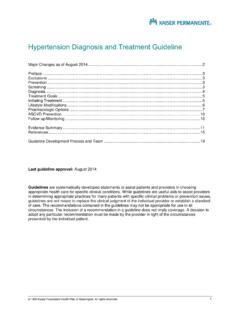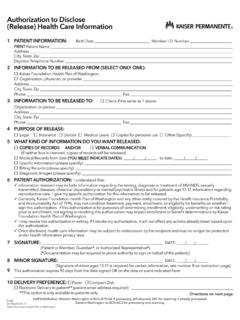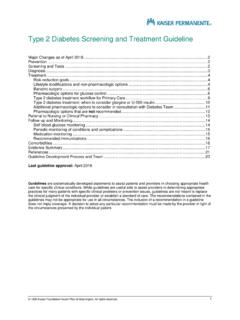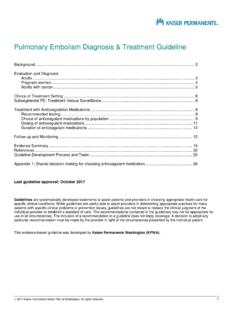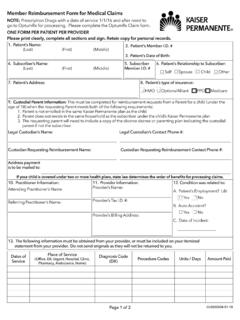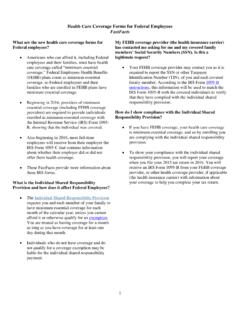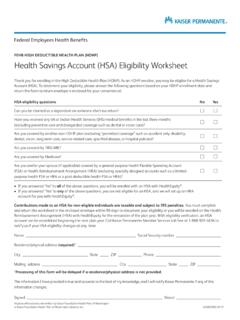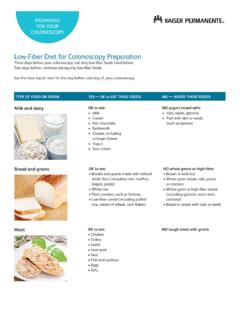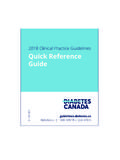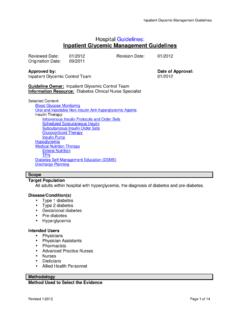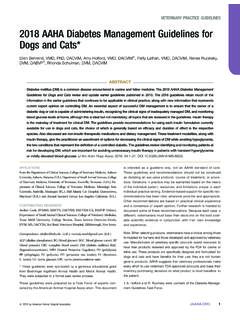Transcription of Gestational Diabetes Guideline - Kaiser Permanente
1 2002 Kaiser Foundation Health Plan of Washington. All rights reserved. 1 Gestational Diabetes Screening and Treatment Guideline Major Changes as of September 2021 .. 2 Screening and Treatment Flowchart .. 3 Screening Recommendations and Tests .. 4 4 Treatment Goals .. 5 Lifestyle modifications/non-pharmacologic options .. 5 Pharmacologic options .. 6 Additional Testing/Monitoring Antenatal monitoring .. 8 Follow-up after delivery .. 8 Referral .. 9 Evidence Summary .. 10 References .. 13 Guideline Development Process and Team .. 14 Last Guideline approval: September 2021 Guidelines are systematically developed statements to assist patients and providers in choosing appropriate health care for specific clinical conditions. While guidelines are useful aids to assist providers in determining appropriate practices for many patients with specific clinical problems or prevention issues, guidelines are not meant to replace the clinical judgment of the individual provider or establish a standard of care.
2 The recommendations contained in the guidelines may not be appropriate for use in all circumstances. The inclusion of a recommendation in a Guideline does not imply coverage. A decision to adopt any particular recommendation must be made by the provider in light of the circumstances presented by the individual patient. 2 Major Changes as of September 2021 New Previous Metformin is first-line treatment for patients whose GDM is not controlled by diet and exercise and have a fasting blood glucose below 126 mg/dL. Insulin, with or without metformin, along with diet and exercise is the first-line treatment for patients who have a fasting blood glucose of 126 mg/dL or higher. Insulin is first-line treatment for patients whose GDM is not controlled by diet and exercise. Pregnant patients who are taking metformin for PCOS are advised to stop taking metformin by the end of their first trimester unless they are found to be hyperglycemic or have evidence of insulin resistance at their first OB visit.
3 There is insufficient evidence on which to base recommendations for continuing metformin during pregnancy for the management of PCOS. All patients with GDM should be referred to a registered dietitian for nutritional counseling. Referral to registered dietitian not mentioned in the Guideline ; KPWA had no RDs in the internal delivery system at that time. A new screening and treatment flowchart has been added. (See following page.) 3 Screening and Treatment Flowchart Patient diagnosed with blood glucose at GDM diagnosis?Offer insulin as first-line treatment, with or without metformin. Use clinical judgment to assess whether level of hyperglycemia warrants adding insulin and metformin at the same pat ient declines insulin, add metformin if not already taking. If level of hyperglycemia warrants it, add glyburide at same time as metformin.
4 If pat ient is intolerant to metformin, switch to 126 mg/dL126 mg/dL or higherBG within target after 1-2 weeks lifestyle modificat ion?Offer metformin as first-line treatment. NOBG within target after 1 2 weeks metformin?Add pat ient declines insulin: Add glyburide if pat ient is tolerating metformin. Switch to glyburide if pat ient is intolerant to metformin. Encourage lifestyle modification (diet and exercise). Urgent referral to registered patientPCOS or other Gestational Diabetes (GDM) risk factors?2-Step Test at 24 28 weeks. If PCOS and taking m etformin, continue metformin if hyperglycemic or showing evidence of insulin resistance at initial OB visit; otherwise, stop metformin b y end of first trimester. Early 2-Step Test at 14 16 weeks. If negative on Early Test, 2-Step Test at 24 28 riskYESHigh riskGDM risk factors Polycystic ovarian syndrome (PCOS)History of GDM BMI > 30 Previous macrosomic baby ( kg)First-degree relative with diabetesEthnicity with high prevalence of Diabetes (Hispanic, American Indian, African American, South Asian) 4 Screening Recommendations and Tests Table 1.
5 Recommendations for screening for previously undiagnosed Diabetes and for Gestational Diabetes 1 Screen for Eligible population Recommended frequency Recommended tests Previously undiagnosed Diabetes All pregnant patients 1 Initial OB visit with nurse HbA1c (as part of OB lab panel) If HbA1c screen is negative but Diabetes is suspected due to symptoms, BMI, or ultrasound findings, a provocative test is recommended (2-step oral glucose tolerance test). Gestational Diabetes Pregnant patients at high risk for GDM 2 Consider screening at 14 16 weeks gestation. 2-step oral glucose tolerance test Pregnant patients not at high risk for GDM 2 Screen at 24 28 weeks gestation. 1 It is reasonable to exclude screening for previously undiagnosed Diabetes if the patient is at low risk for Diabetes and Gestational Diabetes . This would include patients who are Caucasian, young (age < 25), thin, and with no personal or family history of Diabetes .
6 2 Patients at increased risk of Diabetes or Gestational Diabetes include those with a history of Gestational Diabetes ; BMI > 30; previous macrosomic baby (weighing kg); first-degree relative with Diabetes ; ethnicity with high prevalence of Diabetes (Hispanic, American Indian, African American, South Asian); or polycystic ovarian syndrome (PCOS). Diagnosis Table 2. Recommendations for confirming Diabetes diagnosis Diagnosis Recommended tests Positive result parameters Previously undiagnosed Diabetes HbA1c Confirm the diagnosis with two tests done the same day: HbA1c and either fasting plasma glucose or random plasma glucose. Abnormal results on both tests are diagnostic of Diabetes . If only one test produces an abnormal result, that test should be repeated. For more information about the diagnostic process, see the Type 2 Diabetes Guideline .
7 Gestational Diabetes at 24 28 weeks 2-step oral glucose tolerance test Step 1 is nonfasting 1-hour 50 mg glucose tolerance test. o 1-hour result < 135 mg/dL is considered normal. No more testing required. o 1-hour result between 135 mg/dL and 200 mg/dL is considered abnormal and the patient needs to move on to step 2. o 1-hour result 200 mg/dL is considered diagnostic of GDM and does not require any further diagnostic tests. Step 2 is fasting 2-hour 75 mg glucose tolerance test. The patient is diagnosed with GDM if any one of these three values is abnormal: o Fasting 95 mg/dL o 1-hour 180 mg/dL o 2-hour 162 mg/dL 5 Treatment Goals Maintaining glycemic control will lead to improved pregnancy outcomes, including decreases in macrosomia, clinical neonatal hypoglycemia, and cesarean section rates. Lifestyle modifications/non-pharmacologic options Most patients who have Gestational Diabetes can successfully control their blood glucose with diet and exercise.
8 Initiate a trial of lifestyle modifications and provide information about diet and exercise. Diet and nutrition Give simple messages about nutrition: decrease simple sugars, rely more on complex carbohydrates, and increase lean protein and vegetable consumption. Diet recommendations for patients with Gestational Diabetes are different from those for non-pregnant patients with Diabetes , in that the diet for GDM includes both more protein and more fat. Among patients with Gestational Diabetes , 75 80% can achieve normoglycemia through dietary changes. Calorie distribution Opinions regarding the optimal distribution of calories vary. Most programs suggest three meals and three snacks; however, in patients with overweight or obesity the snacks are often eliminated. Below are recommendations for caloric distribution: Breakfast: 10% of total caloric allotment (Carbohydrate intake at breakfast is limited since insulin resistance is greatest in the morning.)
9 Lunch: 30% of calories Dinner: 30% of calories Snacks: 30% of calories Recommended overall total caloric distribution: Carbohydrate: 33 40% Protein: about 20% Fat: about 40% Exercise Moderate exercise is recommended by the American Diabetes Association (ADA): All patients, including those who are pregnant, are encouraged to exercise 1 hour daily. The current intensity and type of exercise should be modified for obvious safety issues ( , activities involving balance, direct contact sports). 6 Pharmacologic options Patient home glucose monitoring Following the diagnosis of Gestational Diabetes , ask patients to begin home glucose monitoring as outlined in Table 3. Ask them to report the results after 1 week of monitoring and every 2 3 weeks thereafter until delivery. Let patients know that they will be informed if any changes to treatment are needed based on those results.
10 Table 3. Home glucose monitoring for patients with Gestational Diabetes Glucose monitoring time Goal Fasting Average < 95 mg/dL Before lunch Before evening meal Average < 95 mg/dL 1 hour after all meals Average < 140 mg/dL If the patient is maintaining good glucose control, consider decreasing home monitoring to twice a day: fasting and 1 hour after the biggest meal. However, the patient should return to the full Table 3 schedule: If, at any time, average readings are not below target, and Periodically throughout pregnancy as dietary needs change. Patients taking metformin for PCOS prior to pregnancy There is insufficient evidence on which to make a strong recommendation about whether to continue metformin during pregnancy for the management of PCOS. Due to limited evidence that suggests that stopping metformin decreases the risks of adverse pregnancy outcomes, including first-trimester loss, we recommend stopping metformin by the end of the first trimester of pregnancy; however, if such a patient is found to have hyperglycemia or evidence of insulin resistance at the initial OB visit, the metformin should be continued.
